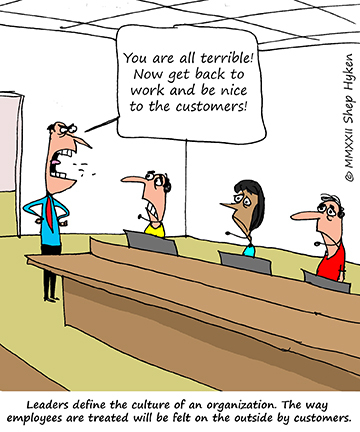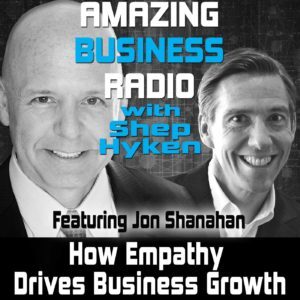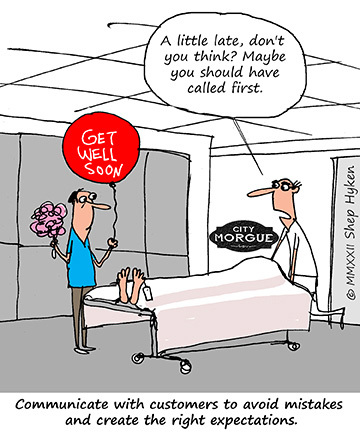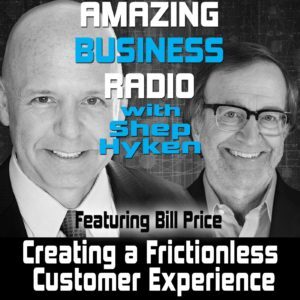Shep Hyken's Blog, page 57
September 19, 2022
5 Top Customer Service Articles of the Week 9-19-2022
Each week I read many customer service and customer experience articles from various resources. Here are my top five picks from last week. I have added my comment about each article and would like to hear what you think too.
4 Ways Brands Are Boosting Customer Loyalty by Scott Clark(CMSWire) Customer loyalty refers to customers who continue to do business with a brand as a preference over competitors. Many factors contribute to customer loyalty, including brand trust, a positive emotional connection, personalized experiences across channels and actionable insights gained from customer feedback. This article will look at the ways brands focus on these four elements to enhance customer loyalty.
My Comment: If you want to build loyalty, you must use all four of the ideas shared in this short, but very effective article. While these ideas seem like common sense, unfortunately, they are as common as they should be. 1. Build trust. 2. Create an emotional connection. 3. Personalize the experience. 4. Collect and act on feedback. The author shares a few ideas and examples on how to deliver on all four of these foundational loyalty strategies.
The ‘invisible’ Future of Customer Experiences by Elliot Maras(Kiosk Marketplace) With all of the innovation taking place in customer engagement tools, it’s hard for brands to know what to focus on: new apps, chat bots, virtual reality, avatars, the metaverse, artificial intelligence. The list goes on.
My Comment: Sometimes, the best customer service is invisible. You don’t see it. It just happens. And you may only notice it if you do business elsewhere and realize something is missing that you used to have. That’s what I was thinking as I started reading the article. It turns out there’s more to it. The author closes the article with this line: “It’s the invisible experiences that will differentiate you.”
6 Types of Customer Loyalty Programs to Help Grow Your Small Business by Social Media Today(Social Media Today) Rewards points, VIP privilege, Tiered programs, Omnichannel programs, Cashback – What is the best loyalty program to help grow your business? Here is an infographic.
My Comment: How many different types of loyalty programs are there? This author claims six. Maybe there are more, but I can’t disagree with the effectiveness of these programs. Of course, you’ll have to decide which is most appropriate for your business type. The author shares the six types of programs and then follows it with an infographic that shares a little more detail.
5 Absurd Advantages Loyalty Programs Bring to Your Business by Newsweekme(Newsweekme) Customers who don’t feel appreciated can take a lot of money from your business. What you need to do is give your customers something to look forward to. Consider the benefits of loyalty programs.
My Comment: As long as we’re talking about different versions of loyalty programs, this article shares some of the benefits of having one. There is nothing new here but good reminders of why we should consider a loyalty program if we don’t already have one.
Employee Branding is a Critical Component of the Customer Experience by Paula Sartini(Media Update) Employees are critical to delivering great customer experiences, says Paula Sartini, founder and CEO at BrandQuantum. Sartini adds that when employees are treated fairly and feel empowered, they in turn deliver better experiences for customers.
My Comment: Years ago, I was the keynote speaker at a Morton’s Steakhouse general managers conference. I remember Tom Baldwin (now the CEO at Benihana’s) sharing how the best marketing department is all of his employees – not a group of people at their headquarters. This article focuses on how employees drive the customer experience, so doesn’t it make sense to consider an employee branding program?
BONUS10 Customer Service Books You Must Read by BookPal(LinkedIn Pulse) How can your company exceed customer expectations and have superior customer service? What can you do to ensure that your customers are experiencing everything your company has to offer? Most importantly how can you turn a potential customer into a loyal customer and brand advocate?
My Comment: This is a great list if you’re looking to read some amazing books on customer experience. I am honored that my book, The Culture of the Customer, made the list. Thank you, BookPal, for this honor!
[image error]Shep Hyken is a customer service expert, professional speaker, and New York Times bestselling business author. Go to The Customer Focus to learn more about our customer service training programs. Follow on Twitter: @Hyken
to learn more about our customer service training programs. Follow on Twitter: @Hyken
The post 5 Top Customer Service Articles of the Week 9-19-2022 appeared first on Shep Hyken.
September 16, 2022
Guest Post: Exploring Natural Language Processing to Categorize Customer Feedback
This week, we feature an article by Sheila Bugal, Head of Marketing at Caplena, a market-leading text analysis tool. She shares how companies can use Natural Language Processing in conjunction with human capabilities to enhance customer service.
Natural Language Processing (NLP) helps computers understand and process human language, which has powerful implications for businesses that want to offer increased communication with customers and clients without the high cost of hiring additional staff. Ever chatted to a chatbot online? Chatbots can answer your questions and offer help because they rely on NLP to evaluate natural human language. However, A.I. – and NLP – aren’t perfect solutions for processing valuable information.
NLP: A Powerful But Imperfect SolutionSome tasks can’t be replicated by a machine. For example, advanced customization, abstract thinking and some types of complex problem solving cannot always be effectively performed by a machine. Businesses who want to use NLP to process customer feedback will find that this type of A.I. has limitations.
When it comes to processing feedback, categorization is king. Categorization helps to efficiently organize feedback into categories like “Customer Service,” “Price,” “Ease of Use,” and “Features.” Then, categories may be divided into subcategories. Categories are key to producing actionable insights on top of rating questions, such as CSAT score (customer satisfaction), net promoter score (NPS), how customers are responding to specific features and why some customers may be unhappy with the product or service.
However, NLP does have its limitations, for example:
Cannot Design MECE CategoriesMutually exclusive and collectively exhaustive (MECE) categories are often used by management consulting firms to help problem solve. The basic premise is that to effectively fix a problem, all potential solutions must be able to fit into only one category (mutually exclusive), and all solutions must fit into a category (mutually exhaustive). MECE categories aim to eliminate confusion and help pinpoint actionable solutions. The ultimate result is that problem-solvers are better able to hone in on a solution that will fix the problem.
While this is a specific application of MECE, this problem-solving framework is also an efficient and effective approach to any type of organization, including that of customer feedback. It helps reduce duplication that could potentially warp metrics, and it allocates every piece of feedback into a category, making it actionable.
Unfortunately, NLP cannot perform MECE organization on its own. MECE requires human intelligence to design a framework of categories that will factor in all possible results and ensure that each result has a mutually exclusive “home.”
Has A Reduced Ability to CustomizeAnother key to efficient categorization is customization. Each business may have a unique set of feedback categories that are best suited to its product, service or type of insight that it’s looking to gain.
For example, most businesses will have feedback categories that apply to satisfaction with customer service or pricing – but some products or services may require additional categories. For example, a time-tracking app will need a unique set of categories that help process customer feedback on its ability to deliver accurate reports. A budgeting app will require categories that help process feedback on how accurately it categorizes purchases and so forth.
NLP can customize categories to a certain extent – but still cannot match human intelligence in terms of creative, insightful customization that will allow owners and analysts to get the most out of customer feedback.
Has Limited Adaptation to Customer-Specific TopicsCustomers may surprise us with “creative” answers they give to otherwise straightforward questions. For example, they may bring up an entirely new issue that hasn’t been addressed by any customer in the past.
In the case of open-ended questions, customers may provide feedback that doesn’t fit into a designated category – and could potentially be handled incorrectly by NLP.
Ultimately, businesses that rely exclusively on NLP will miss out on some of the most valuable outcomes of gathering feedback – such as deep customer insights and accurate metrics (like CSAT and NPS).
And yet, NLP is still highly useful and efficient and well worth investing in. Relying on the power of A.I., it helps automate many aspects of processing customer feedback, which helps businesses save valuable time, money, and energy that can be used on other tasks.
Augmented Intelligence: Combing the Best of Both WorldsGood news: There is a solution.
Augmented intelligence combines artificial intelligence with human intelligence to get the maximum benefits of both: The speedy, automated capabilities of A.I. with the creative, conscious, and even emotional abilities of human intelligence.
In terms of processing customer feedback, businesses that want to use NLP to gather feedback on their websites can still do so. But by relying on augmented intelligence to organize and process this feedback, they’ll get a deeper level of actionable insight into what their customers think, need, and want from their product or service.
Augmented intelligence also has exciting potential to “fill in the gaps” left by artificial intelligence in other industries, such as education and healthcare. For example, augmented intelligence might be used in education to give teachers insights into their student’s learning behaviors and capabilities, but it won’t necessarily replace the teacher. It simply makes the teaching and learning process more efficient.
Ultimately, augmented intelligence is a more effective approach across multiple industries. While artificial intelligence is an exciting solution offering increased efficiency and speed, it’s even better when used with human capabilities.
Sheila Bugal is the Head of Marketing at Caplena, a market-leading text analysis tool, that empowers researchers, consultants, and insight teams to spend less time on the analysis and more time on the results.
 For more articles from Shep Hyken and his guest contributors, go to customerserviceblog.com.
For more articles from Shep Hyken and his guest contributors, go to customerserviceblog.com.
Read Shep’s latest Forbes article: Three Ways Tech Is Improving The Retail Customer Experience
The post Guest Post: Exploring Natural Language Processing to Categorize Customer Feedback appeared first on Shep Hyken.
September 14, 2022
Bad Customer Service Isn’t the Problem. A Bad Culture Is the Problem
 More and more people are complaining about bad customer service. The demand for better service continues to grow, as evidenced in our customer experience research (2022 Achieving Customer Amazement study sponsored by Amazon Web Services). However, customer service trends seem to be heading in the wrong direction. Even several years before the pandemic began, The American Customer Satisfaction Index found the overall ratings slipping, even with brands most recognized for high levels of customer service.
More and more people are complaining about bad customer service. The demand for better service continues to grow, as evidenced in our customer experience research (2022 Achieving Customer Amazement study sponsored by Amazon Web Services). However, customer service trends seem to be heading in the wrong direction. Even several years before the pandemic began, The American Customer Satisfaction Index found the overall ratings slipping, even with brands most recognized for high levels of customer service.
It’s not like companies purposely provide poor customer service. But even though they want to, they can’t seem to execute at a level that makes customers happy. So, let’s consider what could be behind this.
The company has chosen to purposely deliver lousy customer service. Believe it or not, some companies choose to ignore creating a good experience. Despite customers complaining and leaving, they elect not to invest in the people and tools it takes to meet the needs and expectations of their customers. The company wants to deliver a better service experience but can’t seem to make it happen. This is a big problem, and there are many reasons this could occur. Perhaps the company doesn’t have the funds to invest in a better experience. And even if they do have the funds, they may not know where to begin. Maybe they haven’t hired the right people – or enough people. Even with the right people, they haven’t properly trained them. They simply don’t know what to do. The company can’t keep up. Today’s customers are more demanding and have higher expectations of everyone they do business with. They have become educated about what good customer service looks like. They have learned from the best brands in the business, such as Amazon, Lexus, Nordstrom and other brands that raise the bar. The customer now compares you to these rockstar brands, not to your competition. Not realizing this puts any organization at a disadvantage. A bad culture is the problem. The culture of any organization is defined by leadership. It sets the tone and direction for others to follow. Success doesn’t happen by accident. Leaders must work on the culture they want employees and customers to experience. Their vision and plan must provide clarity, keep employees focused and defend the culture if anyone or any group of people go out of alignment with the vision. Unfortunately, some leaders don’t realize this and can’t connect the dots.The first three reasons could all go under number four. It all comes down to the person at the top of the organization deciding to create a culture that drives a positive service experience. On the surface, it may look like a bad service experience comes from bad processes, lack of training and more. Still, it’s typically the decision of leadership to invest the time, energy and dollars into the culture that creates the experience that makes customers say, “I’ll be back.” In short, the customer experience starts and ends with the organization’s culture.
Shep Hyken is a customer service expert, keynote speaker, and New York Times, bestselling business author. For information on The Customer Focus customer service training programs, go to www.thecustomerfocus.com. Follow on Twitter: @Hyken
customer service training programs, go to www.thecustomerfocus.com. Follow on Twitter: @Hyken
The post Bad Customer Service Isn’t the Problem. A Bad Culture Is the Problem appeared first on Shep Hyken.
September 13, 2022
Amazing Business Radio: Jon Shanahan
 How Empathy Drives Business Growth
How Empathy Drives Business Growth Creating a Culture that Gets and Retains the Best Employees
Shep Hyken interviews Jon Shanahan, co-founder of Businessolver Inc., a benefits administration solution that combines technology and service to help employees get the most value out of their benefits. He discusses creating a culture that delights and retains loyal customers and the best employees.






 Top Takeaways:We need to create a culture that people want to work in. Happy employees will focus on engaging more with customers.Employee retention and client retention can drive business growth. You can’t get to client delight unless your employees are delighted. If you want to provide a great customer experience, it starts with a great employee experience.If employees feel like what they contribute to the organization is not recognized in terms of compensation and benefits, they feel like the organization is not empathetic. They think that their leaders are not listening to them.How the workforce views the value surrounding benefits is evolving. Five years ago, employees considered a good medical program the most important benefit (“I have a good medical program that meets my needs. I have a good dental program”). Employees may now put more value on flexibility (“I have flexibility around my work hours and where I work”).Jon Shanahan also shares the top “always” factors that ensure employee retention.Employees always need to know that they will receive their paycheck. Compensation and benefits always have to happen because if they don’t, that is a significant disruption for employees.Employees must know they will always have leaders they can turn to and have honest conversations with.Employees must always have peers that support the same culture.The culture of opportunity. If employees don’t believe they always have opportunities within the company, they will stay with you for a while, but when a new opportunity comes along, they will leave.57% of CEOs believe the most significant benefit of an empathetic workplace is faster business growth. Jon shares more stats from the 2022 State of Workplace Empathy Study. Tune in!Quotes:
Top Takeaways:We need to create a culture that people want to work in. Happy employees will focus on engaging more with customers.Employee retention and client retention can drive business growth. You can’t get to client delight unless your employees are delighted. If you want to provide a great customer experience, it starts with a great employee experience.If employees feel like what they contribute to the organization is not recognized in terms of compensation and benefits, they feel like the organization is not empathetic. They think that their leaders are not listening to them.How the workforce views the value surrounding benefits is evolving. Five years ago, employees considered a good medical program the most important benefit (“I have a good medical program that meets my needs. I have a good dental program”). Employees may now put more value on flexibility (“I have flexibility around my work hours and where I work”).Jon Shanahan also shares the top “always” factors that ensure employee retention.Employees always need to know that they will receive their paycheck. Compensation and benefits always have to happen because if they don’t, that is a significant disruption for employees.Employees must know they will always have leaders they can turn to and have honest conversations with.Employees must always have peers that support the same culture.The culture of opportunity. If employees don’t believe they always have opportunities within the company, they will stay with you for a while, but when a new opportunity comes along, they will leave.57% of CEOs believe the most significant benefit of an empathetic workplace is faster business growth. Jon shares more stats from the 2022 State of Workplace Empathy Study. Tune in!Quotes:“Empathy is your ability to place yourself in someone else’s shoes, understand where they’re coming from, and create a space to listen to understand.”
“If our employees believe that we’re listening and empathetic, this will translate to how they treat customers, and the organization will be rewarded with retention on both sides.”
“Don’t be afraid to be an empathetic leader. Show your weaknesses, be vulnerable, and listen to your employees.”
About:Jon Shanahan co-founded Businessolver, Inc. in 1998. He wanted to create a benefits administration solution that combined the best in technology and service with a fierce focus on the end-user. Before founding Businessolver, Jon was vice president of consulting services at Holmes Murphy & Associates, a leading national insurance agency.
Shep Hyken is a customer service and experience expert, New York Times bestselling author, award-winning keynote speaker, and host of Amazing Business Radio.
This episode of Amazing Business Radio with Shep Hyken answers the following questions and more:
Why is empathy so important in the workplace?How can leaders show compassion to their employees?How does empathy drive business growth?What is employee retention, and why is it important?What is the “Getting to Always Program”?The post Amazing Business Radio: Jon Shanahan appeared first on Shep Hyken.
September 12, 2022
5 Top Customer Service Articles of the Week 9-12-2022
Each week I read many customer service and customer experience articles from various resources. Here are my top five picks from last week. I have added my comment about each article and would like to hear what you think too.
3 Marketing Lessons From Zappos’ Social Media Team by Aaron Templer(Inc. Magazine) Obsessed with the customer experience, Zappos has woven a customer focus throughout everything they do. Their legendary use of social media is no exception, and if we as marketers are willing to shed a bias or two, there are three surprising lessons from Zappos that can transform how brands and agencies derive value from our social media investments.
My Comment: Zappos is one of the iconic customer service brands, known for delighting customers with a level of WOW customer service. How do they do it? Here are three of their success strategies. I especially like number two, “Them, not us.”
How to Overcome the 5 Most Common Customer Service Issues by HR News(HR News) Sometimes, delivering good customer service means eliminating the bad experiences that happen regularly. Awaken Intelligence research has identified the top frustrations for customers – here, customer service specialist Kura offers expert tips on how your business can overcome the top five customer complaints to improve your customer experiences.
My Comment: I’m willing to bet that everyone reading this will have experienced all five of these frustrating customer service experiences. Our customer service research confirms that these five common issues are reasons customers choose to say, “I’m NOT coming back.”
The Top Gun Effect in Customer Experience by Steven Van Belleghem(Steven Van Belleghem) So how could you use the Top Gun Effect to improve the CX of your products and services? And what are your own favorite Top Gun Effect CX stories out there?
My Comment: I’m a huge Steven Van Belleghem fan. I love his take on all things customer experience. I’m also a fan of the “Top Gun” movies. So, I was excited to read Steven’s article and watch his video comparing the movie to a great customer experience.
3 Things You Need to Do to Keep Customers by Jim Schleckser(Inc. Magazine) A ton of research has been conducted over the years on how businesses can best develop relationships with their customers. Most companies aim to keep as many of their customers happy for as long as possible, while minimizing churn or customer turnover. Some companies may even have lofty goals like winning customers for life. But what levers can you pull to help increase your customer retention rate?
My Comment: While there are many strategies and tactics to create repeat and loyal customers, there is no doubt that the three ideas shared in this article will apply to just about every business and industry. Number one is about setting and exceeding expectations. That reminded me of the old saying, “Under promise and over deliver.” And yes, your product must be as good as (or better than) your competitors. Finally, if you want loyalty, create an emotional connection.
Customer Brand Preference and Decisions: Gallup’s 70/30 Principle by Ryan Pendell(Gallup) What motivates consumers to stay loyal to a brand? Are consumers primarily rational actors, looking to maximize benefits for themselves? Or are they driven by impulse, passion and feeling?
My Comment: This article focuses on emotion. As mentioned in the fourth article in this roundup, creating an emotional connection fosters repeat business and loyalty. Emotion can also trigger a buying decision. Gallup’s 70/30 principle finds that 70% of the reason a customer buys is based on emotional factors, and only 30% is based on rational thinking.
[image error]Shep Hyken is a customer service expert, professional speaker, and New York Times bestselling business author. Go to The Customer Focus to learn more about our customer service training programs. Follow on Twitter: @Hyken
to learn more about our customer service training programs. Follow on Twitter: @Hyken
The post 5 Top Customer Service Articles of the Week 9-12-2022 appeared first on Shep Hyken.
September 9, 2022
Guest Post: A Guide To The Foundation Of Cross-Channel Marketing
This week, we feature an article by Juan Jaramillo, Performance Marketing Director for Cordial, a cross-channel marketing and data platform. He shares how cross-channel marketing helps organizations offer consistent messaging across various media and devices.
Marketers have talked about multi-channel marketing for years. Customers engage with businesses through various means, such as email, social media, and text. The multi-channel marketing concept has limits because it assumes that customers will choose a preferred channel and stick with it.
In contrast, cross-channel marketing describes a buyer’s journey that leaps from one channel to another. Savvy marketers understand that customers won’t follow a single track during every engagement. Marketers must keep track of the customer and offer them consistent messaging across various media and devices.
Data: The Foundation of Cross-Channel MarketingCross-channel marketing introduces more complexity but can reward marketers who approach it with the right strategy and tools. Research uncovered almost 300 percent more sales and about 90 percent higher engagement rates for companies with cross-channel marketing strategies.
Cross-channel marketing offers a realistic view of today’s consumers, who often alternate between various devices and media during the buyer’s journey. For instance, the customer might:
Click through to a sales page after engaging with a social media post Browse the product information, navigate to the home page, and chat with an online rep for more information Switch from email to text messages for greater mobile access Make a mobile purchase in response to a promotional message Chat online with customer service to resolve an issueNo matter which media or device customers employ, they need to receive the right message at the right time along their path to remain engaged. Thus, marketers need accurate, real-time information to keep customers engaged.
Real-Time Data Supports the Five Pillars of Cross-Channel MarketingAn effective cross-channel marketing strategy relies upon these five pillars.
#1: The four w’s
Data must inform marketers of what, when, where, and who for each conversation on every channel. Real-time data collection ensures customers receive the appropriate message and lets marketers make on-the-spot adjustments.
#2: Key customer insights
Timely data lets businesses gain key insights, such as:
Where customers first engaged with the brand and what they’ve learned since that first engagement How many steps and how much time has passed before the customer commits to a purchase Exactly which channels a customer engaged with along the wayCurrent, actionable data allows businesses to deliver timely, relevant messaging and keep up with inevitable customer behavior changes.
#3: Consistent messaging across channels and content types
Ensure customers recognize they’re seeing the same core messaging that attracted them in the first place. At the same time, content containing the messaging may vary to reflect its source and goals. For instance, social media influencer campaigns to promote brands will differ from text messages announcing promotional offers. At the same time, all communication should reflect the brand’s core identity and values.
#4: A call to action that reflects the customer’s shopping stage
The right call to action will depend upon the customer’s stage in their buying journey. After viewing a social media post, the call to action may propel customers to visit a sales page or enroll in a promotional subscription list via email or text. In contrast, subscription messaging might strive to close sales through promotional offers or notifications of new products. Data can inform the appropriate call to action, and marketers must ensure it’s easy to spot and understand.
#5: Test-and-learn approach
As with any marketing, perfect cross-channel marketing campaigns are made and not born. Data offers marketers the information they need to constantly measure and adjust campaigns to serve customers better and optimize conversions and sales growth.
How Can Businesses Capture and Employ the Data They Need?Effective cross-channel marketing doesn’t just rely on any data. It requires tools that provide actionable, real-time information that marketers can use to offer personalized, engaging experiences, make rapid adjustments, and uncover opportunities to perform better. Customers enjoy better experiences, no matter how they engage with a brand. In turn, brands benefit from higher sales and conversion rates.
Juan Jaramillo is Performance Marketing Director for Cordial, a cross-channel marketing and data platform. He has 13 years of experience in the industry and focuses on performance marketing, search engine optimization, and analytics.
 For more articles from Shep Hyken and his guest contributors, go to customerserviceblog.com.
For more articles from Shep Hyken and his guest contributors, go to customerserviceblog.com.
Read Shep’s latest Forbes article: Discomfort May Lead To Your Next Breakthrough
The post Guest Post: A Guide To The Foundation Of Cross-Channel Marketing appeared first on Shep Hyken.
September 7, 2022
This Is How to Communicate with Customers
 In our customer service workshops, we do an exercise in which we ask participants what their favorite companies are to do business with and why. We almost always get Amazon as an answer. One of its success traits is communication. When a customer places an order, he or she is immediately notified by email. Another email is sent once the order ships with tracking information. And another is sent to inform the customer the package has arrived. Frequent communication is one of the reasons customers have so much confidence in Amazon.
In our customer service workshops, we do an exercise in which we ask participants what their favorite companies are to do business with and why. We almost always get Amazon as an answer. One of its success traits is communication. When a customer places an order, he or she is immediately notified by email. Another email is sent once the order ships with tracking information. And another is sent to inform the customer the package has arrived. Frequent communication is one of the reasons customers have so much confidence in Amazon.
One of our clients sells to businesses (B2B). When one of the employees shared that Amazon was his favorite company and mentioned the emails, an executive raised his hand and said that this doesn’t apply, as they were in the manufacturing business, not retail. On the contrary! Communication is not limited to B2C companies and brands.
Kevin Paige, one of our subscribers, owns a tobacco store and placed an order with International Plastics, Inc. He was so impressed with their communication that he shared it with us. The short letter contained the following:
“Thank you for your order! Attached is your confirmation. At International Plastics, Inc., we greatly appreciate your business. For questions, please contact me at extension 114 or call our customer service team at 800-820-4722.” Lynn Skupien, senior sales rep, signed it and included her direct phone number and email.
But there’s more. On Monday morning, Lynn called and left a voice mail to inform us that the item had shipped and when to expect delivery. In Kevin’s words, “What a heads up and FANTASTIC customer service experience. They told me who I could reach out to if my expectations were not met and adjusted my expectations by sharing when my delivery should be. I’m giddy!”
There are several important lessons and reminders here: You don’t have to be Amazon to have amazing communication. There was plenty of communication: First to confirm the order, second to inform of the shipping, and third to establish a delivery expectation. There was ownership. This wasn’t a faceless corporate email. The email included a person and phone number, just in case, there was a problem or question.Kevin wrote to me, “I’m giddy!” That’s a great word, giddy, and I can understand why. He feels a stronger connection to his supplier for the communication reasons above, as well as for a connection to someone “on the inside.” Kevin now has a go-to person if there are any issues.
Find ways to communicate – even over-communicate – with your customers. It creates confidence and credibility and gives the customer a sense of control.
Shep Hyken is a customer service expert, keynote speaker, and New York Times, bestselling business author. For information on The Customer Focus customer service training programs, go to www.thecustomerfocus.com. Follow on Twitter: @Hyken
customer service training programs, go to www.thecustomerfocus.com. Follow on Twitter: @Hyken
The post This Is How to Communicate with Customers appeared first on Shep Hyken.
September 6, 2022
Amazing Business Radio: Bill Price
 Creating a Frictionless Customer Experience
Creating a Frictionless Customer ExperienceHow to Engage the “Whole of Business” to Solve Customer Issues
Shep Hyken interviews Bill Price, Amazon’s first global vice president of customer service, founder and president of Driva Solutions, and co-author of The Frictionless Organization: Deliver Great Customer Experiences with Less Effort. He shares how organizations can engage the “whole of business” to create a frictionless experience.






 Top Takeaways:There are now more channels for customers to contact companies, making it easier than ever for them to do so. But, what most companies aren’t asking is: Why do they need to contact us? Who can address these issues in the organization?Frictionless is something that often goes unnoticed. It means that everything is going so well that customers don’t need to contact the companies they are doing business with. For the business, it means the contact rate goes down, and the Net Promoter Score and customer loyalty go up.When customers experience a frictionless experience with another company, they may say something to you, like, “Why aren’t you as easy as Amazon?” or, ‘When I had to return something to Nordstrom, that was really easy, and it’s really hard when I try to return something to you.” Recognize these comments as opportunities to improve and meet your customer’s expectations.Identifying why customers are contacting you makes it easy for anybody on the receiving end to pick it up, whether in sales, customer service, or an AI bot.By looking at the frequency and reasons customers contact you, you can figure out the issues that frustrate them the most.If an issue is frustrating for your customers and solving it is time-consuming and expensive, businesses need to do a root cause analysis and eliminate it from happening. Companies need to figure out how to engage all areas and departments of the business to find the solution. By engaging the “whole of business,” an organization can eliminate the most frustrating and frequent issues its customers face.Quotes:
Top Takeaways:There are now more channels for customers to contact companies, making it easier than ever for them to do so. But, what most companies aren’t asking is: Why do they need to contact us? Who can address these issues in the organization?Frictionless is something that often goes unnoticed. It means that everything is going so well that customers don’t need to contact the companies they are doing business with. For the business, it means the contact rate goes down, and the Net Promoter Score and customer loyalty go up.When customers experience a frictionless experience with another company, they may say something to you, like, “Why aren’t you as easy as Amazon?” or, ‘When I had to return something to Nordstrom, that was really easy, and it’s really hard when I try to return something to you.” Recognize these comments as opportunities to improve and meet your customer’s expectations.Identifying why customers are contacting you makes it easy for anybody on the receiving end to pick it up, whether in sales, customer service, or an AI bot.By looking at the frequency and reasons customers contact you, you can figure out the issues that frustrate them the most.If an issue is frustrating for your customers and solving it is time-consuming and expensive, businesses need to do a root cause analysis and eliminate it from happening. Companies need to figure out how to engage all areas and departments of the business to find the solution. By engaging the “whole of business,” an organization can eliminate the most frustrating and frequent issues its customers face.Quotes:“The best service is no service. The best thing to do for our customers is to set up everything so well that they don’t need to contact us for help and support.”
“It doesn’t matter what kind of business you have. What matters is that customers just want things to be easy for them. They want things to be frictionless.”
“If you don’t make it really simple and easy for customers, someone else will do it for you.”
About:Bill Price was Amazon’s first global vice president of customer service and is the founder and president of Driva Solutions, a consultancy dedicated to creating highly effective customer contact strategies and operations. He is the co-author of The Best Service Is No Service, Your Customer Rules! and The Frictionless Organization: Deliver Great Customer Experiences with Less Effort.
Shep Hyken is a customer service and experience expert, New York Times bestselling author, award-winning keynote speaker, and host of Amazing Business Radio.
This episode of Amazing Business Radio with Shep Hyken answers the following questions and more:
What does “whole of business problem” mean? What is a frictionless customer experience?How do you eliminate the most frustrating issues for your customers?What does a frictionless experience mean for the business?How can you remove friction from your business?The post Amazing Business Radio: Bill Price appeared first on Shep Hyken.
September 5, 2022
5 Top Customer Service Articles of the Week 9-5-2022
Each week I read many customer service and customer experience articles from various resources. Here are my top five picks from last week. I have added my comment about each article and would like to hear what you think too.
4 Ways Digital Evolution Has Changed Customers’ Ideas About Patience by Scott Clark(CMSWire) We know that customers expect answers to service inquiries within an hour, and they also expect their online experiences to be convenient and fast, with their questions answered and their goals accomplished. How has the ongoing digital evolution impacted how customers view patience today? How has your business reacted to customers’ limited patience? What can brands do to perform within their customers’ expectations?
My Comment: Customers don’t want to wait on hold, they demand instant access to customer support, and they have little patience for poor experiences. It’s that simple. Our customer experience research confirms this, finding that 74% of consumers would switch to a competing company brand if they provided a better customer service experience. (The article quotes a survey that claimed 64% of consumers would switch. Close enough!)
“We Serve To Serve Again” by Fred Reggie(Fred Reggie) Take a look at your business and ask yourself, “Does our business serve our customers or does it serve us?” You may discover that your business might be more competitive and productive by refining the focus of how your serve your customers. Are you in business to “serve to serve again”?
My Comment: When I was a kid, I worked at gas stations. I loved the motto of the author’s father’s Sinclair service station. “We Serve to Serve Again!” Isn’t that what we should do? Let’s give the customer an experience that makes them want to say, “I’ll Be Back.”
Could NPS Detractors Be A Good Thing? New Evidence Says Yes by Dan Gingiss(Dan Gingiss) NPS Detractors, the Net Promoter Score (NPS) survey respondents who rate your business between 0 and 6, are typically referred to in a negative light. This is because they’re the most likely customers to churn if they have the chance. But what you don’t hear is that they’re also your most valuable. And maybe, they’re also your future Promoters.
My Comment: My friend and fellow customer service expert, Dan Gingiss (a.k.a. The Experience Maker), has written an excellent article about why a low NPS (Net Promoter Score) can be a good thing. Yes, even negative feedback and ratings can be positive.
The Remarkable Customer Experience Recovery System and Digital Transformation by Are Morch(Hospitality Net) In the hotel industry, we have traditionally emphasized customer service and customer service recovery. Customer service is the assistance and advice provided to a customer for a hotel’s product or service as needed. And customer service recovery have represented the ability of a hotel to solve a dissatisfied customer’s problem through good customer service. The principles of customer service and customer service recovery have been built around data from surveys, customer forums, inspections, audits, dedicated customer research, reviews, and reputation management tools.
My Comment: I always enjoy learning from the hospitality industry. Even if you’re not in the hospitality business, you can still have a hospitality mentality. When you see the word hotel in this article, just mentally swap it with the word “business.” The article includes a short tip on journey mapping, creating an experience vision, and more.
7 Engagement Lessons I Wish We Knew 7 Years Ago by Wise Marketer Staff(The Wise Marketer) If a company believes it is using the right words with its customers, it needs to ask itself two big questions: 1) How do we know what they want to hear? And 2) How the heck do they even hear us?
My Comment: Do you tell your customers what they want to hear? I’ll add that it’s also what they need to hear. This is an interesting article about communicating and engaging with your customers. While all seven strategies may not apply to your business, I’m willing to bet at least one or two, probably more, will.
[image error]Shep Hyken is a customer service expert, professional speaker, and New York Times bestselling business author. Go to The Customer Focus to learn more about our customer service training programs. Follow on Twitter: @Hyken
to learn more about our customer service training programs. Follow on Twitter: @Hyken
The post 5 Top Customer Service Articles of the Week 9-5-2022 appeared first on Shep Hyken.
September 2, 2022
Guest Post: Build Your Winning Customer Experience Strategy With These Quick Tips
This week, we feature an article by Sukhdev Singh, Digital Marketing Specialist at Maxicus, a company that provides tech-enabled customer service solutions. He shares some tips for building a winning customer experience strategy.
Companies that provide a seamless customer experience have a better chance of creating a loyal audience in the long run. According to Forbes Insights Report, 74% of people are willing to buy from a business based on a good customer experience alone. Some studies point to customers being willing to spend extra for a better experience.
Customer experience for a business encompasses many components like the ease of use, reliability of products and services, advertising, communication, packaging, etc. While all these components are essential for building a positive customer experience, customer service is one of the most critical aspects of this equation. Customer experience in BPO profoundly impacts building a positive customer experience in any organization.
What is a Customer Experience Strategy?A customer experience strategy can be defined as the process of mapping, defining, and documenting the approach to improve customer experience in an organization. A robust customer experience strategy can help an organization achieve its goals. You can build your winning customer experience strategy with these quick tips.
How to Improve Customer Experience?There are quite a few ways that can help you build a solid strategy to improve customer experience. Here are some useful tips that can help you build a winning customer experience strategy in your organization:
Review your existing customer service strategyThe first step in improving your customer service strategy is to review the organization’s existing processes for customer service. As they say, you can only improve what you can measure. Understanding what customer service practices are working well for your brand and which practices need to change is essential. You can start with analyzing numbers like net promoter score, customer churn rate, customer satisfaction score, etc. It will help you get an overview of the strengths and weaknesses of the business in customer service.
Understand your customersBefore you get down to making radical changes in your customer experience strategy, it is a good idea to understand your customers properly. You can get started by understanding their requirements, expectations, and challenges. One way of doing it would be to create various personas by segmenting your customers. For instance, various types of customers buy products and services of a particular business. With the identification and segmentation of each customer type, you would be better positioned to improve the experience.
Build an efficient omnichannel experienceGone are the days when the phone was the only channel people used to connect for assistance. Other platforms, like websites, apps, social media, chat, email, etc., exist for customer assistance. An organization needs to build an efficient omnichannel experience that is consistent, reliable, and responsive. Customers expect companies to provide a consistent experience and information across channels.
Provide real-time assistance for real-time feedbackIf you are getting real-time feedback, it is good practice to provide real-time assistance to a customer. Similar to the experience on a phone call, you can extend this experience to other mediums like websites and apps using chatbots. This can help you provide ready answers to the most commonly asked questions and have a team ready to help with serious queries. With real-time assistance, you can expect a massive improvement in the organization’s customer service level.
Use technology for improvementThere are several tools and technologies available today for almost all business functions. It is similar to customer service. You have a bunch of efficient tools available to improve customer experience. You must select the right ones as per your needs. For instance, modern tools can help you map the customer journey, build decision trees, understand what customers say about your brand online, and more. You must select the tools per your needs and use technology to improve the customer experience.
Create self-service solutionsToday’s modern consumer is more aware than ever. As a result, it makes sense for brands to create self-service solutions like e-books, videos, tutorials, etc., that can help a customer find solutions to the problems they are facing on their own. Based on the industry you are from and the challenges consumers face, you should create self-service solutions to improve the customer experience.
Measure, iterate, and measure againAnother vital tip for a robust customer experience strategy would follow the consistent process of measuring the performance of your customer service team. Based on the results you get, make the changes in the processes and measure again. You need to follow this cycle to improve the experience for the customer. You can also use the results of various parameters to check the quality of service and work towards enhancing them to provide a better customer experience.
Focus on simplicity and ease of useCustomers are usually wary of complex processes and products. It is better to create a simple and easy-to-use product or service to help a customer navigate the process easily. A simple interface that is easy to use improves the customer experience and can help establish a successful brand in the long run. You should be proactive in your approach to customer service and ensure that the team is trained in handling customer queries easily.
Sukhdev Singh is a Digital Marketing Specialist at Maxicus as an Associate Digital Marketing Specialist. He handles the company’s organic marketing efforts, mainly focusing on SEO, Content Marketing, and lead generation.
 For more articles from Shep Hyken and his guest contributors, go to customerserviceblog.com.
For more articles from Shep Hyken and his guest contributors, go to customerserviceblog.com.
Read Shep’s latest Forbes article: Six Ways To Create Trust With Your Employees
The post Guest Post: Build Your Winning Customer Experience Strategy With These Quick Tips appeared first on Shep Hyken.



